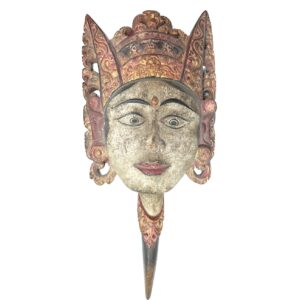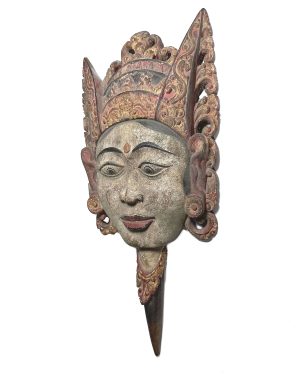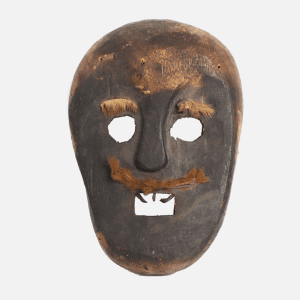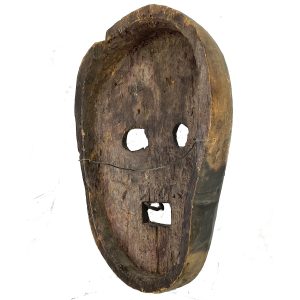Showing 25–29 of 29 results
-


$265.00
H: 14.5″ W: 6.625″ D: 2.375″ | FREE SHIPPING
This very fine and very beautiful vintage woodcarving of Dewi Sri , Devi Sri or Sridevi in Java, the Balinese Hindu goddess of rice and prosperity, is in excellent condition considering it is a much used vintage piece. Personally collected in Bali in the 1970s, it reflects the offerings made to Dewi Sri placed in the rice fields to protect the rice harvest. She is depicted here as a young, attractive and fertile woman wearing a striking, highly detailed and decorative headdress similar to those worn in Balinese dances leaving her upper forehead bare and framing her oval face with high curved eyebrows, wide-open eyes and beautiful pursed lips. With its flat back it can be mounted on a wall.
-


$185.00
H: 10.5” Dia: 4.25″ | FREE SHIPPING WITHIN CONTINENTAL U.S.!
Made in Pagan this miniature hsun ok demonstrates the remarkable sense of design of Burmese wood carvers. It is crafted in two separate parts and replicates the shape of larger hsun-Ok, which traditionally have covers with spired lids topped by elegant finials that imitate the soaring outline of Burmese stupa finials. This modest piece has circular tiers repeated on the foot and the stupa finial top.
-


$240.00
Ht: 9.75″ W: 3.5″ D: 2.5″ | FREE SHIPPING WITHIN CONTINENTAL U.S. !
This Chinese Republic Period delicate porcelain figurine holds a rose at her heart in her right snow white hand, her left arm covered by her shawl resting on a waist-high decorative vase with an opening to hold incense (joss) sticks. Her shawl drapes over her shoulders and lower garment with floral motifs extending to the beaded belt at her waist. The sweet facial expression with slightly smiling bowed lips is framed by her piled hair looped in a chignon over each ear. Given her luxurious garments and accessories, she is an aristocratic woman. The rose was often used on porcelains during this period, representing eternal spring.
-


$395.00
This rare folk art Rangda mask was made on the island of Lombok, Indonesia by ethnic Balinese Hindu craftsman. Primarily Muslim, a Balinese Hindu minority ruled the island from 1750-1895 and Hindu temples (pura) have been centers for Balinese activities since the 17th century. Balinese girls are encouraged to “dance with their hands” and formal…
-
Sale!


$495.00 Original price was: $495.00.$325.00Current price is: $325.00.
H: 12.5″ W: 8.625″ D: 2.75″ | FREE SHIPPING IN CONTINENTAL U.S.!
Timor masks like this are rare and characterized by large roughly cut eyes, the absence of some teeth and the remaining ones being menacing. They are stored in the rafters above the house hearth accounting for their smoky black color. Often decorated with animal hide with hair, the facial pieces have either not darkened fully in the rafters or, when placed on top of each other, did not darken evenly. Frequently a bit threatening due to the black color, missing teeth and their frequent lack of balance, these ancestral masks are used in offering rituals designed to drive off malevolent spirits.
End of content
End of content









